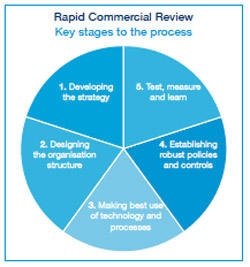Making the top line the top priority

Pricewaterhouse Coopers Retail and Consumer Group looks at opportunities for companies to improve the efficiency of their sales operations.
21 July 2009
Even in good times growth is hard to get. Profitable incremental growth is even harder to achieve. No one’s interested in short-term gains at the expense of long-term profitability, but there’s always the temptation to sacrifice margin for market share, especially in the face of an economic downturn. It doesn’t have to be that way. Even in challenging markets there’s plenty you can do to grow your top line and protect your profits at the same time.
Customer is king
It’s easier and cheaper to keep an existing customer than it is to get a new one. However, the mistake that many companies make is putting time and money into marketing rather than into customer management.
Long-term and sustainable revenue growth is about putting the customer at the heart of everything you do and tracking how effectively you’re doing it. With the evolution of new channels and the disintegration of traditional buying patterns, there needs to be an even greater commitment to the customer, shared across the whole organisation, especially in the face of what could be a prolonged downturn.
David McGee is responsible for leading PwC’s Retail and Consumer Performance Improvement (PI) team and specialises in helping clients in the retail sector to grow revenue and improve the efficiency and effectiveness of their sales operations.
David comments: "It’s vital that companies have a thorough understanding of their market, customers and competitors. This is where real opportunities can be identified. Companies can then focus resources on their sales operation, and make smarter choices about the channels they use. It also allows you to shift the emphasis from the profitability of your products to the profitability of your customers, so that your investments are targeted towards the ones worth chasing. This doesn’t just apply to business-to-business selling. One big brand retailer grew its operations while successfully dealing with a reorganisation and a challenging realignment across all of its core infrastructure and support arrangements."
Trade investment
One key area which should be focused on is trade investment. This area can often be the poor relation of the marketing budget, or worse still a black hole of expenditure that no one really understands. It’s hard to believe that 18 to 23% of consumer goods companies’ revenue is typically spent here, most likely in the form of payments made to retailers to display, discount, and promote a company’s products, including offers like ‘three-for-two’ or ‘buy-one-get-one-free.’ The sums involved aren’t just a huge cost to the business but a potentially enormous opportunity to get a better return. In a recession, getting better value for money here is even more vital, and could even make the difference between survival and success.
David notes: "We’ve seen a number of producers and suppliers work more actively with their retail customers to analyse what they’ve actually achieved from trade investments. They analysed which investments have worked, why, and with whom. Adding discipline, transparency and accountability to the process allows businesses to focus on what’s profitable and to cut what’s not."

The diagnostic-style approach (shown above) scrutinises a business’ sales, marketing and service functions and compares them to best practice, highlighting the areas of weakness for targeted improvement effort
The results can be quite a revelation, especially for businesses that have never undertaken an in-depth analysis of their trade investments before. For example, the answer for one major food company was to sharpen up its control and compliance processes, and as a result it’s now getting far more value from its significant investment in supermarket groups. Another company was doing different promotions with two or three different retailers but was not aware which were working and which were not.
Proper evaluation helped them sharpen up their approach and target it more effectively, adapting their activities to the customer base in each outlet. Likewise a food supplier involved in supplying the raw material for special offers like the M&S ‘Dinner for two for €12.50′ needed to have a very clear idea about how much they were contributing, and how much value they were realising from it.
The lessons here are obvious enough. Trade investments may be an unavoidable fact of life for companies who supply the major retailers, but that doesn’t mean they can’t be managed more effectively and make a much bigger contribution to the bottom line.
With the right approach to tackling current business challenges, you can still sustain growth. However, it is critical to understand the areas of your business that are contributing to top line growth and bottom line profitability, and focus management attention on those areas where there is the greatest return on investment.



 Print
Print






Fans 0
Followers